wheel Citroen DS4 RHD 2011.5 1.G Owner's Guide
[x] Cancel search | Manufacturer: CITROEN, Model Year: 2011.5, Model line: DS4 RHD, Model: Citroen DS4 RHD 2011.5 1.GPages: 396, PDF Size: 12.14 MB
Page 176 of 396

Ty r e u n d e r - i nfl ation detection
System which automatically and continuously checks the pressure of the tyres while driving.Sensors fitted in each valve trigger a warning
in the event of problem (speed above 12 mph(20 km/h)).
Puncture
The tyre under-inflation detectionsystem is an aid to driving which doesnot replace the need for the driver to bevigilant or to drive responsibly.
Under-infl ated tyre
This warning lamp is displayed on the
instrument panel and/or a message appears
in the screen, accompanied by an audible
si
gnal, to identify the wheel concerned.
The STOPwarning lamp comes on and/or this warning lamp is displayed on
the instrument panel, accompanied by
an audible signal and a message in the
screen identifying the wheel concerned.
�)Stop as soon as it is safe to do so, avoiding any sudden movement of the steering
wheel and the brakes.�)Repair or change the damaged wheel(punctured or very deflated tyre), and have
the tyre pressure checked as soon as possible.
�) Check the tyre pressures as soon as possible.
This check must be carried out when the tyres
are cold.
Page 177 of 396
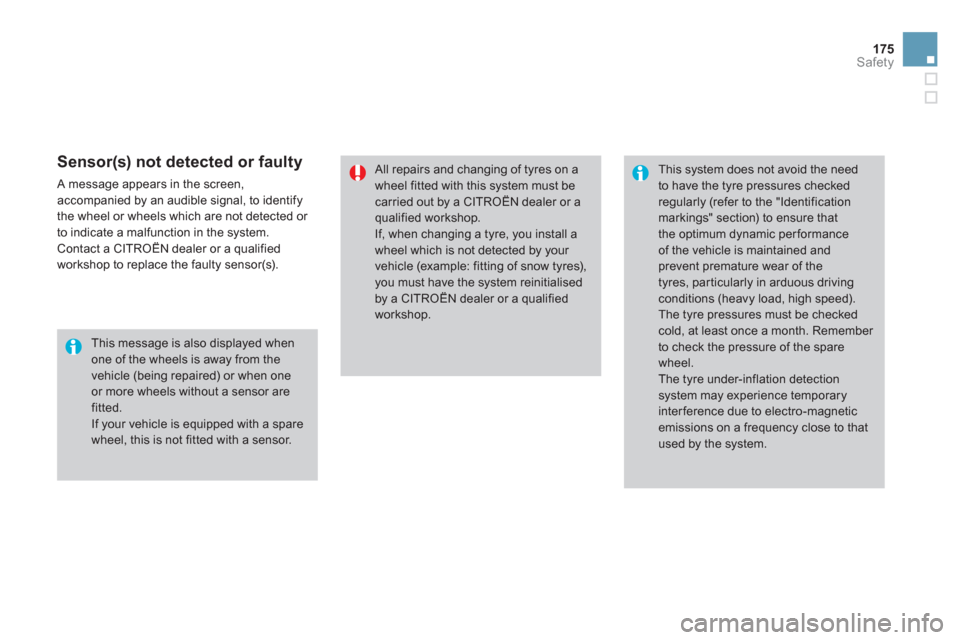
175
Safety
Sensor(s) not detected or faulty
A message appears in the screen,
accompanied by an audible signal, to identify
the wheel or wheels which are not detected or
to indicate a malfunction in the s
ystem.
Contact a CITROËN dealer or a qualified
workshop to replace the
faulty sensor(s).
All repairs and changing of tyres on a wheel fitted with this system must be carried out by a CITROËN dealer or aqualified workshop.
If, when changing a tyre, you install a wheel which is not detected by your vehicle (example: fitting of snow tyres),you must have the system reinitialised by a CITROËN dealer or a qualified workshop.
This system does not avoid the needto have the tyre pressures checkedregularly (refer to the "Identificationmarkings" section) to ensure that
the optimum dynamic performanceof the vehicle is maintained andprevent premature wear of the tyres, particularly in arduous driving conditions (heavy load, high speed). The tyre pressures must be checked cold, at least once a month. Remember to check the pressure of the spare wheel. The tyre under-inflation detection system may experience temporary inter ference due to electro-magnetic emissions on a frequency close to thatused by the system.
This message is also displayed when one of the wheels is away from the vehicle (being repaired) or when oneor more wheels without a sensor are fitted.
If your vehicle is equipped with a spare wheel, this is not fitted with a sensor.
Page 178 of 396
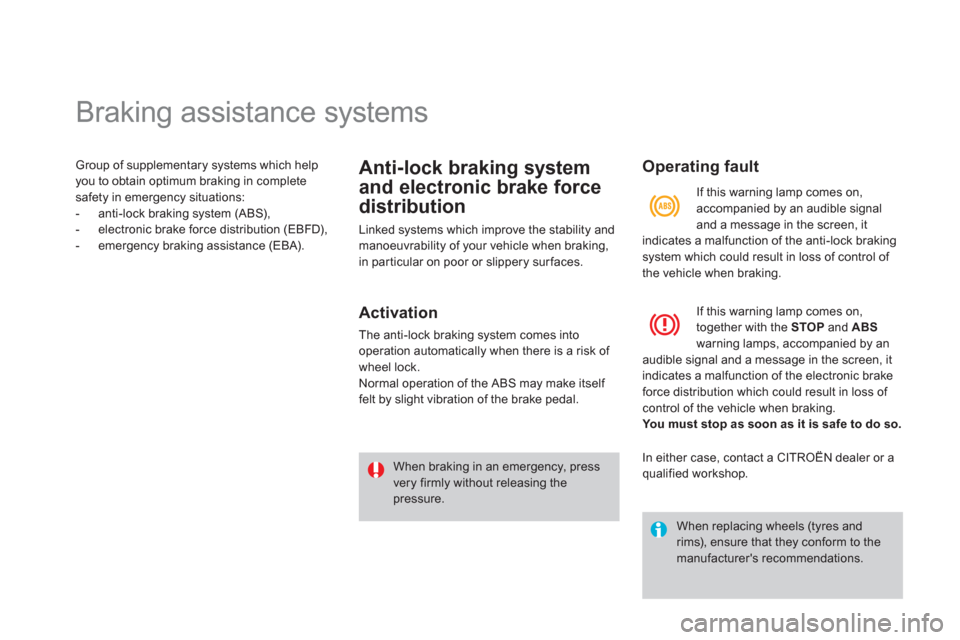
Braking assistance systems
Group of supplementary systems which helpyou to obtain optimum braking in complete safety in emergency situations:
- anti-lock braking system (ABS),
- electronic brake force distribution
(EBFD),
- emergency braking assistance (EBA).
Anti-lock braking system
and electronic brake force
distribution
Linked systems which improve the stability and
manoeuvrability of your vehicle when braking,
in par ticular on poor or slippery surfaces.
Activation
The anti-lock braking system comes into
operation automatically when there is a risk of
wheel lock.
Normal operation of the ABS may make itself
felt by slight vibration of the brake pedal.
When braking in an emergency, pressvery firmly without releasing thepressure.
Operating fault
If this warning lamp comes on,
together with the STOPand ABSwarning lamps, accompanied by an
audible signal and a message in the screen, it
indicates a malfunction of the electronic brake force distribution which could result in loss of control of the vehicle when braking.You must stop as soon as it is safe to do so.
When replacing wheels (tyres andrims), ensure that they conform to themanufacturer's recommendations.
If this warnin
g lamp comes on,
accompanied by an audible signaland a message in the screen, it
indicates a malfunction of the anti-lock brakingsystem which could result in loss of control of
the vehicle when braking.
In either case, contact a CITROËN dealer or a
qualified workshop.
Page 179 of 396

177Safety
Emergency braking assistance
System which, in an emergency, enables you
to obtain the optimum braking pressure more
quickly, thus reducing the stopping distance.
Activation
It is triggered by the speed at which the brake pedal is pressed.
The effect of this is a reduction in theresistance of the pedal and an increase in
braking efficiency.
When braking in an emergency, press firmly without releasing the pressure.
Trajectory control systems (ESP)
Anti-slip regulation (ASR)
and electronic stability
control (ESC)
The anti-slip regulation (also known as traction control) optimises traction to prevent skidding
of the wheels, by acting on the brakes of the
driving wheels and on the engine.The electronic stability control acts on the
brake of one or more wheels and on the engine
to keep the vehicle on the trajectory required
by the driver, within the limits of the laws of physics.
Activation
These systems are activated automaticallyeach time the vehicle is started.
They come into operation in the event of a gripor trajectory problem.
This is indicated b
y flashing of this
warning lamp in the instrument panel.
Intelligent traction control
s
ystem ("Snow motion")
Your vehicle has a system to help driving on snow: intelligent traction control.
This system detects situations of difficult surface adhesion that could make it difficult to
move off or make progress on deep fresh snowor compacted snow.
In these situations, the intelligent tractioncontrol limits the amount of wheel slip to
provide the best traction and trajectory control
for your vehicle.
The use of snow tyres is strongly recommended on surfaces offering low levels of adhesion.
Page 180 of 396
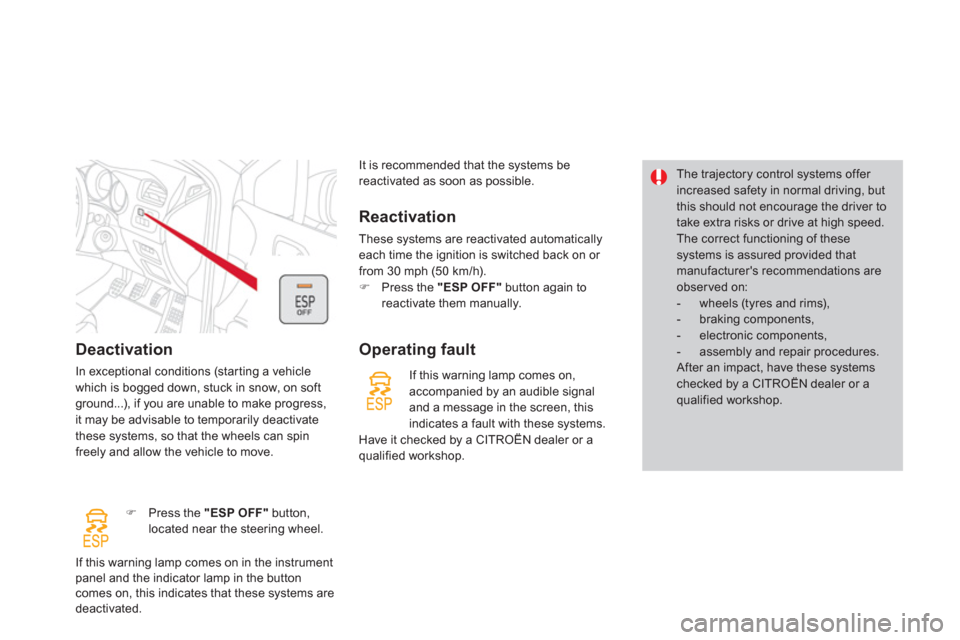
Deactivation
In exceptional conditions (starting a vehicle
which is bogged down, stuck in snow, on softground...), if you are unable to make progress,it may be advisable to temporarily deactivate
these systems, so that the wheels can spinfreely and allow the vehicle to move.
�) Press the "ESP OFF"
button,located near the steering wheel.
Reactivation
These systems are reactivated automatically each time the ignition is switched back on or from 30 mph (50 km/h).�)
Press the "ESP OFF"
button again to
reactivate them manually.
Operating fault
The trajectory control systems offer increased safety in normal driving, butthis should not encourage the driver to take extra risks or drive at high speed.
The correct functioning of these systems is assured provided thatmanufacturer's recommendations areobserved on:
- wheels (tyres and rims),
- braking components,
- electronic components,
- assembly and repair procedures.
After an impact, have these systems checked by a CITROËN dealer or a qualified workshop.
I
f this warning lamp comes on,
accompanied by an audible signal
and a message in the screen, this
indicates a fault with these systems.
Have it checked by a CITROËN dealer or aqualified workshop.
It is recommended that the systems bereactivated as soon as possible.
If this warnin
g lamp comes on in the instrumentpanel and the indicator lamp in the buttoncomes on, this indicates that these systems aredeactivated.
Page 186 of 396

Front airbags
System which protects the driver and frontpassenger in the event of a serious front impact
in order to limit the risk of injury to the head and
thorax.
The driver's airbag is fitted in the centre of the steering wheel; the front passenger's airbag is fitted in the dashboard above the glove box.
Deployment
The airbags are deployed simultaneously,unless the passenger's front airbag is
deactivated, in the event of a serious front
impact to all or par t of the front impact zone A ,
in the longitudinal centreline of the vehicle on a
horizontal plane and directed from the front to
the rear of the vehicle.
The front airbag inflates between the thorax
and head of the front occupant of the vehicle
and the steerin
g wheel, driver's side, and the
dashboard, passenger's side to cushion their
forward movement.
Page 190 of 396
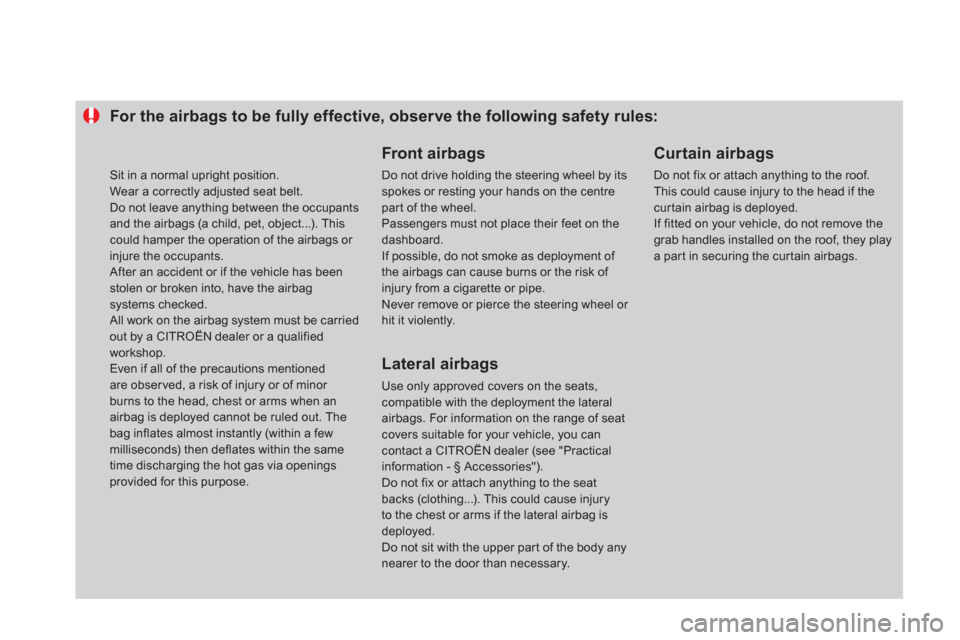
For the airbags to be fully effective, observe the following safety rules:
Front airbags
Do not drive holding the steering wheel by its spokes or resting your hands on the centre par t of the wheel.
Passengers must not place their feet on thedashboard.
If possible, do not smoke as deployment of the airbags can cause burns or the risk of injury from a cigarette or pipe.
Never remove or pierce the steering wheel or hit it violently.
Lateral airbags
Use only approved covers on the seats,compatible with the deployment the lateral airbags. For information on the range of seat covers suitable for your vehicle, you cancontact a CITROËN dealer (see "Practicalinformation - § Accessories").
Do not fix or attach anything to the seat backs (clothing...). This could cause injury to the chest or arms if the lateral airbag isdeployed.
Do not sit with the upper par t of the body any nearer to the door than necessary.
Curtain airbags
Do not fix or attach anything to the roof. This could cause injury to the head if thecurtain airbag is deployed.
If fitted on your vehicle, do not remove the grab handles installed on the roof, they play a par t in securing the cur tain airbags.
Sit in a normal upright position.
Wear a correctly adjusted seat belt.
Do not leave anything between the occupantsand the airbags (a child, pet, object...). This could hamper the operation of the airbags or injure the occupants. After an accident or if the vehicle has beenstolen or broken into, have the airbagsystems checked. All work on the airbag system must be carriedout by a CITROËN dealer or a qualified workshop.
Even if all of the precautions mentioned are obser ved, a risk of injury or of minor burns to the head, chest or arms when an airbag is deployed cannot be ruled out. The
bag inflates almost instantly (within a few milliseconds) then deflates within the sametime discharging the hot gas via openings provided for this purpose.
Page 195 of 396

193Driving
With the ignition on or the engine running, torelease the parking brake, press on the brakepedalor the accelerator, pull then release
control A
.
Manual release
Before leaving the vehicle, ensurethat parking brake warning lamp inthe instrument panel is on fixed, not flashing.
Manual application
With the vehicle stationary, to apply the parkingbrake whether the engine is running or off, pullcontrol lever A.
The application of the parking brake is confirmed by:
- illumination o
f the braking warninglamp and of the P
warning lamp in
the control lever A,
- displa
y of the message"Handbrake on".
When the driver
’s door is opened with the engine running, a message is displayed
accompanied by an audible signal if the parkingbrake has not been applied, except in the case
of an automatic gearbox with the gear lever in position P.P
The full application of the parking brake is confirmed by:
- the brakin
g warning lamp and
the P warning lamp in the controllever Agoing off,
- displa
y of the message
"Handbrake off".
I
f you pull control lever A
without
pressing the brake pedal, the parkingbrake will not be released and awarning lamp will come on in the
instrument panel.
Maximum application
If necessary, you can make a maximum application
of the parking brake. This is obtained by means of a long pullon the control
l
ever A, until you see the message "Handbrake on maximum" and a beep is heard.
Maximum application is essential:
- in the case of a vehicle towing a caravan
or a trailer, if the automatic functions are
activated but you are applying the parkingbrake manually,
- when the gradient you are parked on may
vary (e.g. on a ferry, on a lorry, duringtowing).
In the case of towing, a loaded vehicle or parking on a gradient, make amaximum application of the parkingbrake then turn the front wheelstowards the pavement and engage agear when you park.
After a maximum application, the release time will be longer.
Page 196 of 396
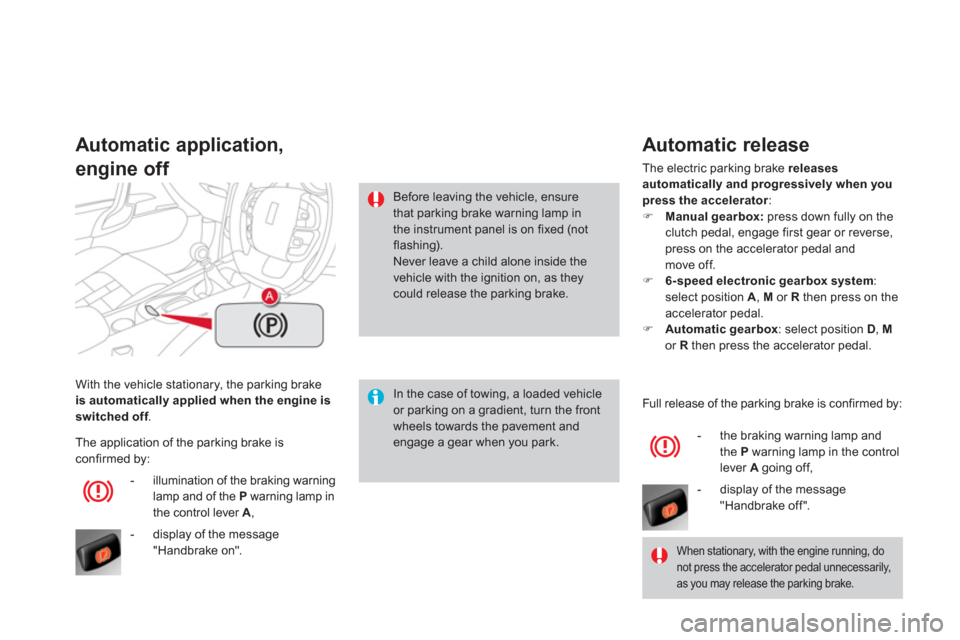
With the vehicle stationary, the parking brake is automatically applied when the engine is
switched off.
Automatic application,
engine off
In the case of towing, a loaded vehicleor parking on a gradient, turn the front wheels towards the pavement and engage a gear when you park.
Before leaving the vehicle, ensurethat parking brake warning lamp inthe instrument panel is on fixed (notflashing). Never leave a child alone inside the vehicle with the ignition on, as they could release the parking brake.
- illumination o
f the braking warninglamp and of the P
warning lamp in
the control lever A ,
- displa
y of the message "Handbrake on". The application of the parkin
g brake is confirmed by:
Automatic release
The electric parking brake releasesautomatically and progressivelywhen you press the accelerator: �)Manual gearbox:
press down fully on the clutch pedal, engage first gear or reverse,press on the accelerator pedal andmove off.�)6-speed electronic gearbox system:select position A
, M
or Rthen press on theaccelerator pedal. �)Automatic gearbox
: select position D, Mor Rthen press the accelerator pedal.
When stationary, with the engine running, donot press the accelerator pedal unnecessarily, as you may release the parking brake.
Full release of the parking brake is confirmed by:
- the brakin
g warning lamp and
the Pwarning lamp in the control lever A
going off,
- displa
y of the message"Handbrake off".
Page 198 of 396

In the event of the electric parking brakemalfunctioning or the battery running flat, anemergency manual device can release theparking brake.�)Immobilise the vehicle (or keep it
stationary, if the brake pedal is pressed),
with the engine running, by engagingfirst gear (manual gearbox), position P(automatic gearbox) or position M or R(6 -speed electronic gearbox system).
Emergency release
�)
Switch off the engine but leave the ignition on. If it is not possible to immobilise the
vehicle, do not operate the control andcontact a CITROËN dealer or a qualified
workshop without delay.�) Fetch the two vehicle blocks B
and the
release device C, located under the boot carpet.
�)Immobilise the vehicle by placing the blocks
in front or behind the two front wheels,
opposite to the direction of the slope.�)Remove the storage box under the bootcarpet for access to the emergency releasedevice.